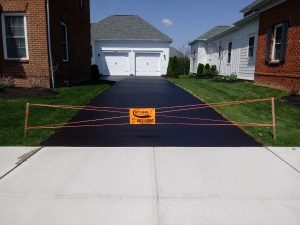Discover the Power of Industrial Parking Lot Paving and Asphalt Sealing
Discover the Power of Industrial Parking Lot Paving and Asphalt Sealing
Blog Article
Hot Mix Asphalt: A Lasting Option for Pavement
Hot Mix Asphalt (HMA) has become a leading lasting selection for pavement options, offering a myriad of ingenious technologies and ecological advantages. Its capability to minimize and reuse materials power usage provides a compelling case for its adoption in road building tasks. The lasting efficiency and durability of HMA make it a favored option for framework growth. As the demand for environment-friendly building methods expands, exploring the nuances of HMA's sustainability can supply useful insights right into the future of pavement options.
Ecological Benefits of Warm Mix Asphalt

Moreover, Hot Mix Asphalt helps to reduce city warm island impacts. Its dark color absorbs sunlight, minimizing the amount of warm mirrored back right into the atmosphere compared to lighter-colored sidewalks. This can lower ambient temperatures in metropolitan locations, reducing the demand for cooling and ultimately minimizing power consumption.
Additionally, Warm Mix Asphalt contributes to improved stormwater administration. Its permeable nature enables water to penetrate the sidewalk and reenergize groundwater supplies, reducing runoff and the danger of flooding. These environmental benefits make Warm Mix Asphalt a lasting option for leading highways and roadways.
Power Efficiency in HMA Production
Is power efficiency a vital aspect in the production of Warm Mix Asphalt (HMA)? Definitely. Energy plays a considerable duty in the manufacturing of HMA, impacting both cost and environmental sustainability. One crucial facet of power effectiveness in HMA production is the use of cozy mix asphalt (WMA) technologies (regrading). WMA permits the blending and positioning of asphalt at lower temperature levels contrasted to standard warm mix asphalt, leading to decreased energy consumption throughout manufacturing. This procedure not just decreases fuel usage however also decreases greenhouse gas discharges, making it an extra environmentally friendly option.
Additionally, developments in plant innovations have led to even more energy-efficient HMA production processes. By enhancing power usage in HMA production, the industry can reduce its carbon footprint while preserving premium sidewalk products.
Recyclability of Hot Mix Asphalt
The recyclability of Warm Mix Asphalt (HMA) is a critical facet of its sustainability and lasting environmental influence. HMA is just one of one of the most recycled products in the United States, with over 100 million lots of recovered asphalt sidewalk (RAP) being reused every year in brand-new sidewalk construction. Recycling HMA offers numerous environmental advantages, such as lowering the demand for virgin materials, decreasing power usage during manufacturing, and reducing the amount of waste sent out to garbage dumps.
The process of reusing HMA entails crushing the existing pavement, crushing it right into smaller sized pieces, and mixing it with brand-new accumulation and asphalt binder to produce a recycled mix. This recycled mix can usually perform in addition to and even far better than standard HMA, while calling for fewer basic materials and generating lower greenhouse gas exhausts. By integrating RAP right into new sidewalk jobs, roadway companies can conserve natural deposits, reduce prices, and decrease the ecological footprint of road building and maintenance activities. Overall, the recyclability of HMA plays a substantial role in advertising sustainable practices within the sidewalk market.

Long-Term Performance of HMA
Asphalt sidewalks show longevity and durability over a prolonged period, mirroring the long-term efficiency of Hot Mix Asphalt (HMA) In addition, advancements in HMA technology, such as the use of polymer-modified binders and cozy mix asphalt, have actually even more boosted the resilience and durability of HMA sidewalks. By prioritizing top quality building and maintenance methods, HMA continues to show itself as a lasting and affordable remedy for durable sidewalk infrastructure.

HMA: Toughness and Sustainability
Demonstrating both toughness and sustainability, Warm Mix Asphalt (HMA) has become a keystone in the building of durable pavement infrastructures - commercial parking lot paving. HMA's durability originates from its ability to stand up to heavy loads, extreme weather condition problems, and high traffic quantities, making it a dependable choice for roads, highways, and flight terminal paths. The composition of HMA, which usually consists of aggregates, binder, and filler, plays a crucial duty in boosting its look what i found long life and resistance to tear and use
Furthermore, HMA's sustainability depends on its recyclability and energy-efficient manufacturing procedure. The capacity to reuse recovered asphalt sidewalk (RAP) in brand-new HMA mixes lowers the demand for virgin materials and lessens the ecological impact of sidewalk building and maintenance. In addition, the energy performance of producing HMA hinges on its reduced blending temperature levels compared to various other sidewalk products, bring about minimized power intake and greenhouse gas emissions.
Conclusion
In final thought, warm mix asphalt (HMA) provides a sustainable remedy for pavement with its ecologically friendly attributes. HMA's recyclability, energy efficiency in manufacturing, and long-lasting durability make it an environment-friendly option for roadway building.
HMA is one of the most recycled materials in the United States, other with over 100 million bunches of recovered asphalt sidewalk (RAP) being recycled yearly in new sidewalk construction.The procedure of recycling HMA entails grating the existing sidewalk, crushing it right into smaller pieces, and mixing it with brand-new aggregate and asphalt binder to develop a recycled mix.Asphalt sidewalks show toughness and resilience over a prolonged period, reflecting the lasting performance of Hot Mix Asphalt (HMA) In addition, developments in HMA modern technology, such as the use of polymer-modified binders and cozy mix asphalt, have even more boosted the resilience and long life of HMA pavements. The capability to reuse redeemed asphalt pavement (RAP) in new HMA combinations reduces the demand for virgin products and lessens the environmental effect of advice sidewalk construction and maintenance.
Report this page